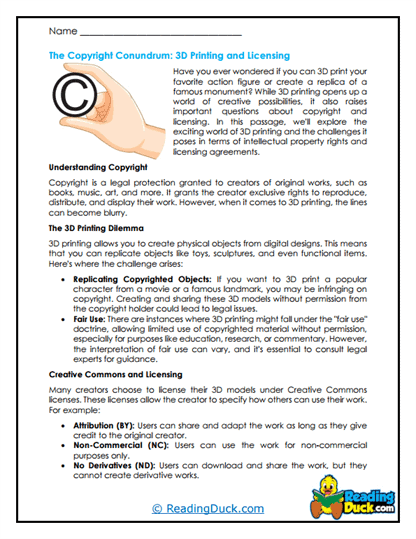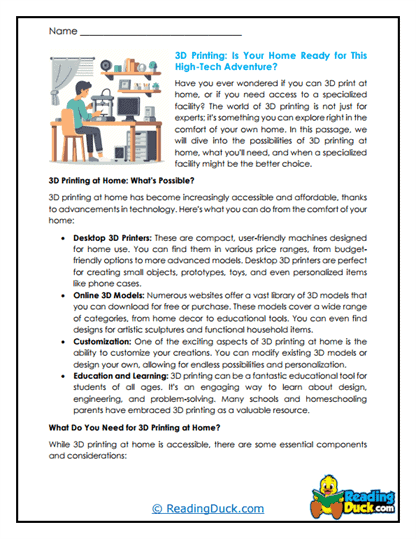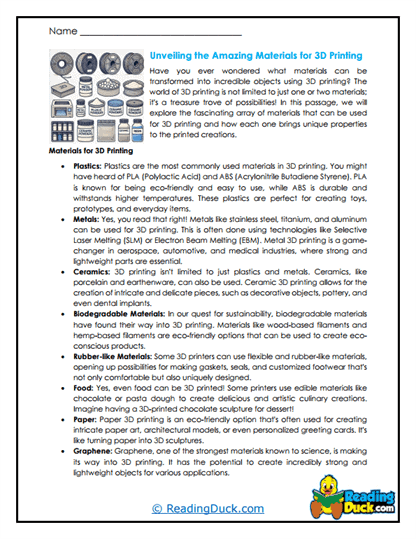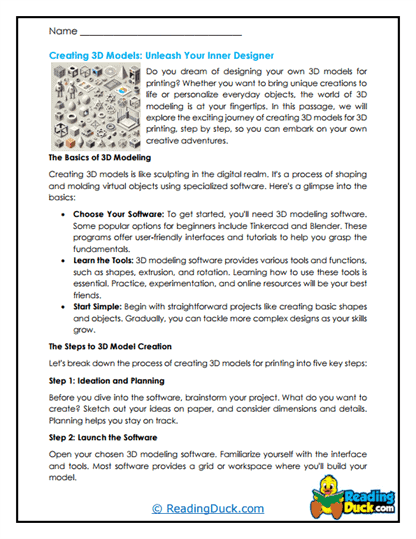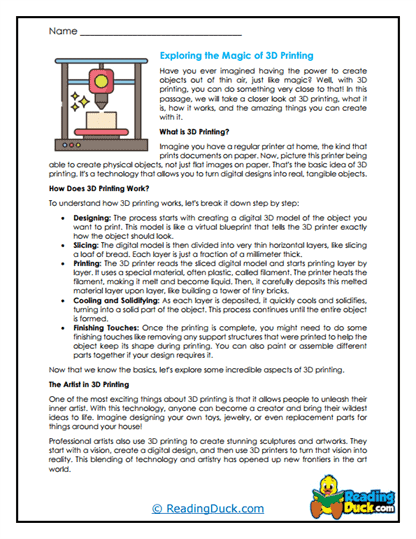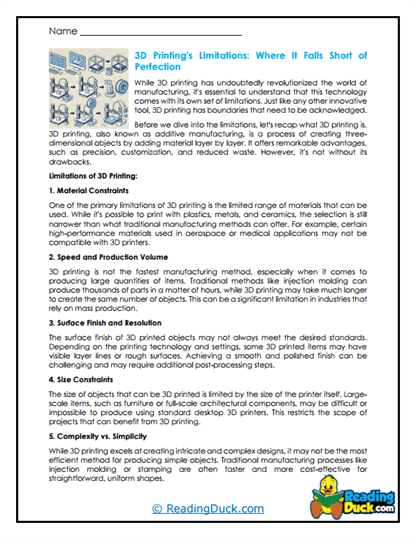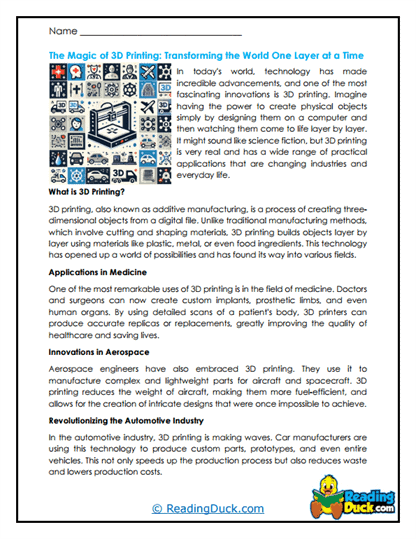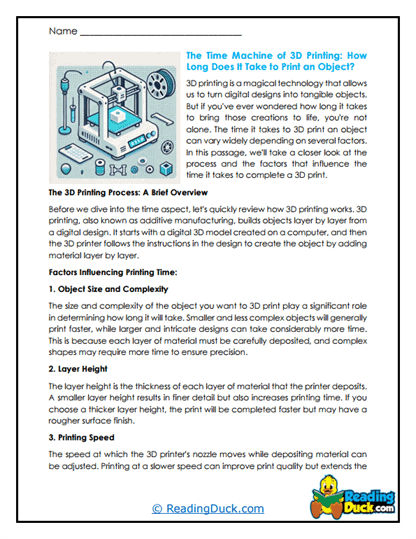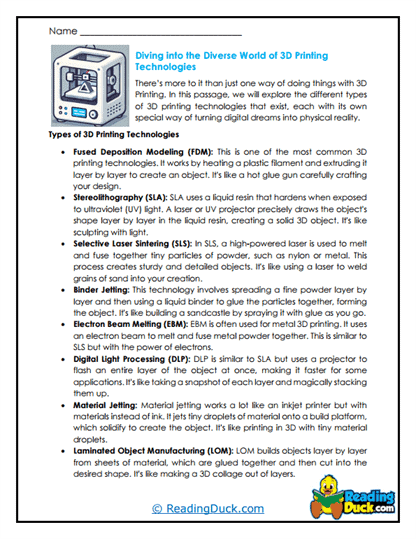3D Printing Worksheets
About Our 3D Printing Worksheets
Our 3D Printing Worksheets provide an engaging and comprehensive exploration of one of the most exciting advancements in modern technology. These worksheets are designed to help students understand the fundamental concepts and applications of 3D printing, a technology that is rapidly transforming industries, from manufacturing to healthcare. Each worksheet set includes a reading passage that is both informative and visually engaging, accompanied by comprehension questions that encourage students to think critically about the material.
Each worksheet set features:
- Multiple Choice Questions: These questions test students' grasp of key concepts and details from the reading passage, reinforcing their understanding of 3D printing's fundamental aspects.
- Short Answer Questions: These questions require students to articulate their understanding in their own words, promoting deeper comprehension and the ability to express ideas clearly.
- Open-Ended Questions: These questions encourage students to connect personally with the material, offering their own opinions, preferences, and reflections on what they have learned, thereby enhancing their engagement with the topic.
These worksheets are designed to not only assess students’ comprehension but also to foster a deeper connection with the material. Each set includes an answer key for easy assessment, and the PDF format makes these resources easily accessible for immediate download and use in any learning environment.
The Revolution of 3D Printing: Understanding the Future of Manufacturing
3D printing, also known as additive manufacturing, is a revolutionary technology that allows objects to be created layer by layer from a digital file. This method contrasts with traditional manufacturing techniques, which often involve cutting away material to achieve the desired shape. The potential of 3D printing spans numerous industries, including healthcare, aerospace, automotive, and even fashion, making it a topic of immense interest and relevance in today's technological landscape.
The Basics of 3D Printing
To begin understanding 3D printing, it's essential to grasp the basic principles that underlie this technology. The worksheets introduce students to the concept of additive manufacturing and explain how a 3D printer works. They cover the different types of 3D printing technologies, such as Fused Deposition Modeling (FDM), Stereolithography (SLA), and Selective Laser Sintering (SLS). Students also learn about the various materials used in 3D printing, ranging from plastics and metals to ceramics and even biological materials.
Applications of 3D Printing
One of the most fascinating aspects of 3D printing is its wide range of applications. The worksheets delve into how 3D printing is revolutionizing industries:
- Healthcare: 3D printing is being used to create custom prosthetics, implants, and even organs, offering new possibilities in personalized medicine.
- Manufacturing: From rapid prototyping to the production of complex parts, 3D printing is changing how products are designed and manufactured.
- Education: 3D printing is a powerful tool in education, enabling students to bring their ideas to life and learn through hands-on experimentation.
- Art and Fashion: Artists and designers are using 3D printing to create intricate and innovative works that would be impossible to achieve with traditional methods.
These examples help students see the real-world impact of 3D printing and inspire them to think about how they might use this technology in their future careers.
The Future of 3D Printing
The future of 3D printing is full of exciting possibilities. The worksheets guide students through discussions on emerging trends and future applications, such as 3D-printed homes, food, and even space exploration. Students are encouraged to think critically about the ethical and environmental implications of 3D printing, such as its potential to reduce waste in manufacturing and its role in democratizing production by making tools and products more accessible.
Creative Uses for These Worksheets
Incorporating 3D Printing Worksheets into your curriculum or homeschool setup can significantly enhance students’ learning experience and foster a deeper interest in this cutting-edge technology. Here are some practical and creative ways to use these worksheets effectively:
1. Hands-On Projects Encourage students to apply what they’ve learned by designing their own 3D models using free software like Tinkercad or Blender. After completing the worksheets, students can create simple designs and, if possible, print them using a 3D printer. This hands-on experience helps solidify their understanding of the material and brings the concepts to life.
2. Cross-Curricular Connections Integrate the 3D Printing Worksheets with other subjects. For example:
- Science: Explore the use of 3D printing in biology and medicine, such as creating models of organs or the use of bioprinting.
- Math: Discuss the geometry involved in 3D modeling, such as understanding shapes, volume, and spatial reasoning.
- Art and Design: Encourage students to explore the artistic side of 3D printing by designing sculptures, jewelry, or other creative projects.
3. Group Discussions and Debates Use the open-ended questions as a basis for group discussions or debates. For example, you could have students debate the ethical implications of 3D printing in medicine or the potential environmental impact of widespread 3D printing. This helps students develop critical thinking skills and learn to articulate and defend their ideas.
4. Virtual Field Trips Take advantage of online resources to give students a virtual tour of industries that use 3D printing. Many companies offer virtual tours or videos that show their 3D printing processes in action. This can help students connect the concepts they learn in the worksheets to real-world applications.
5. Creative Writing Assignments Encourage students to imagine the future of 3D printing and write a short story or essay about how they envision this technology will evolve and impact the world. This allows students to think creatively while reinforcing their understanding of the material.
6. Guest Speakers and Workshops If possible, invite a guest speaker who works in the field of 3D printing to talk to your students, either in person or via a virtual platform. This could be a local maker, an engineer, or a healthcare professional who uses 3D printing in their work. Students can prepare questions based on the worksheets, making the session more interactive and relevant to their studies.
7. Parent Involvement Encourage parents to engage with their children’s learning by discussing the worksheets at home. Parents can help students with hands-on projects or explore 3D printing resources together, such as online tutorials or visiting a local maker space.
8. Explore Emerging Technologies Use the 3D Printing Worksheets as a starting point to explore other emerging technologies covered in the Technology category, such as Artificial Intelligence, Autonomous Vehicles, or Blockchain. This can help students see the connections between different areas of technology and how they influence each other.
9. Interactive Quizzes and Games Incorporate interactive quizzes or games to review the material covered in the worksheets. There are many online platforms that allow you to create custom quizzes or games that can make learning about 3D printing more fun and engaging.
10. Display Student Work Showcase students’ 3D printing projects or written assignments in a class display or virtual gallery. This not only motivates students to do their best work but also allows them to take pride in their achievements and see how their peers approached the same topic.
By integrating these 3D Printing Worksheets into your teaching strategy, you can create a dynamic and engaging learning environment that not only educates students about the technology but also inspires them to think creatively about its potential applications. These worksheets are designed to be versatile and accessible, making them an essential resource for educators looking to inspire their students and foster a lifelong interest in technology.
